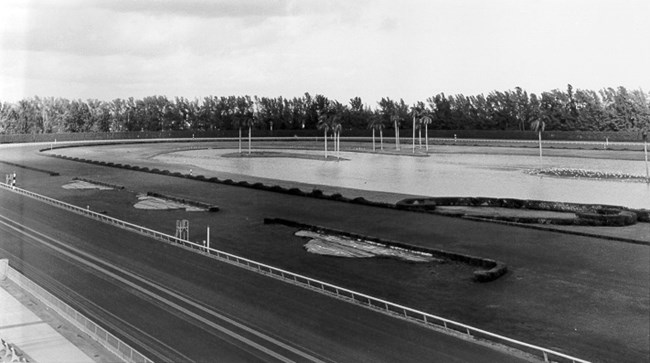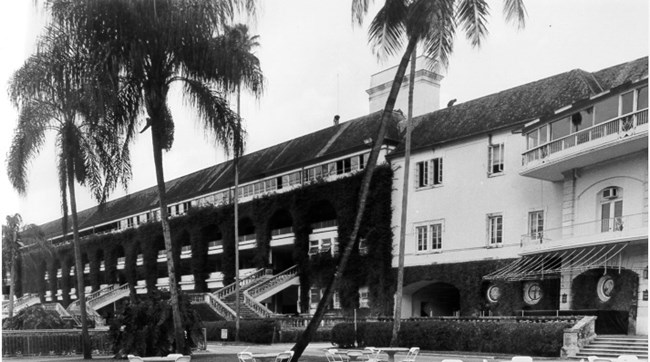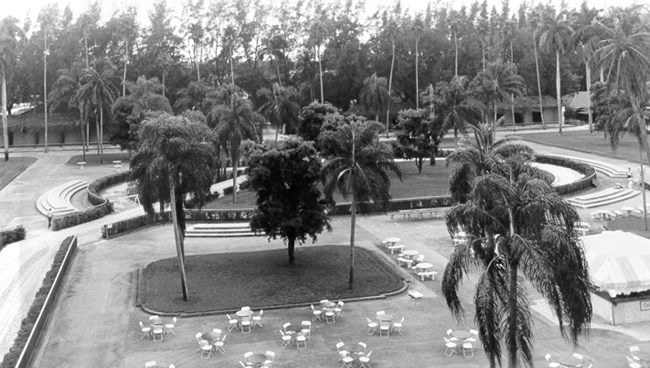
NPS Photo / Mary Turnipseed
The Hialeah Park Racetrack is one of the oldest existing recreational facilities in southern Florida. Originally built to attract the rich and famous, Hialeah Park has contributed to the popularization of South Florida as a winter resort. The park includes a Renaissance Revival clubhouse, associated buildings, and landscaped gardens of native flora and fauna. Hialeah Park has become so famous for its flocks of flamingos that it has been officially designated a sanctuary for the American Flamingo by the Audubon Society.
The development of the racetrack is closely linked to the development of the City of Hialeah. Developed as a speculative enterprise in 1921 by James H. Bright, a cattleman from Missouri, and Glenn H. Curtiss, an aviation pioneer, it included many amenities ignored by other South Florida town developers. Bright and Curtiss donated land for community use and helped to acquire land and building funds for the construction of public buildings and facilities, including a racetrack. The first greyhound parimutuel track in America was opened here in February of 1922 by the Miami Kennel Club. The track was developed by Owen P. Smith, the inventor of the "Inanimate Hare Conveyor," the mechanical rabbit device that allowed dog racing on a circular track.

NPS Photo / Mary Turnipseed
In 1924, Joseph M. Smoot, with the help of Curtiss and Bright, established the Miami Jockey Club and constructed a racetrack and grandstand adjacent to the greyhound track. The Hialeah Racetrack that opened on January 15, 1925, consisted of a clubhouse, an administrative building, a paddock area, and twenty-one stables. Near the track, a fronton (an arena specifically for jai alai) for the Spanish sport of jai alai was constructed, the first in the Miami area. An amusement park with a roller coaster and a dance hall was also developed. Hialeah Park offered the most complete recreational complex in South Florida at that time. The Great Hurricane of September 1926 dealt the City of Hialeah a staggering blow. The racetrack complex lost its roller coaster, jai alai fronton, and dog kennels. From that point on, the various owners of the Hialeah Park Racetrack concentrated on horse racing.

NPS Photo / Mary Turnipseed
The racetrack was purchased in 1930 by Joseph E. Widener, who undertook a major renovation, hiring architect Lester W. Geisler to design a master plan for the sporting facility. This master plan included the replacement of the wooden grandstand and clubhouse structures with concrete and steel buildings on the existing foundations. Also included in the master plan were the stables, paddock area, walking rink, and the infield turf track, now the widest and oldest track continuously used in the United States. Extensive landscaping was undertaken, with hundreds of royal palms and coconut trees planted, and a lake was created within the track infield and populated with pink flamingos imported from Cuba. The opening of the renovated Hialeah Racetrack on January 14, 1932, set its tone for years to come. It was attended by the rich and notable who rode special trains south from Palm Beach and debarked at a station specially built by the Seaboard Airline Railway.
Hialeah Park is nationally significant as the oldest and widest continuously operating turf horse racing track in the United States. The association of famous jockeys, such as Eddie Arcaro and Willie Schumacher, with the track enhances its significance. Equally significant is Hialeah Park's role in starting the careers of famous horses such as Citation and Seattle Slew, that went on to success in the Kentucky Derby and other classics. Hialeah Park hosts several nationally famous races such as the Flamingo, Widener, and Turf Cup. The track has been the major industry of the City of Hialeah since its opening and has made Florida the capital of winter racing. The reputation of the Hialeah Park Racetrack as the world's most beautiful race course has helped South Florida to become known as a desirable vacation spot. In this way, it has played a significant role in the development of South Florida tourism and was a forerunner of modern recreational complexes in South Florida
Hialeah Park Racetrack was listed in the National Register of Historic Places on March 2, 1979. On January 12, 1988, the property was determined eligible for designation as a National Historic Landmark by the Secretary of the Interior.
Last updated: July 24, 2018
